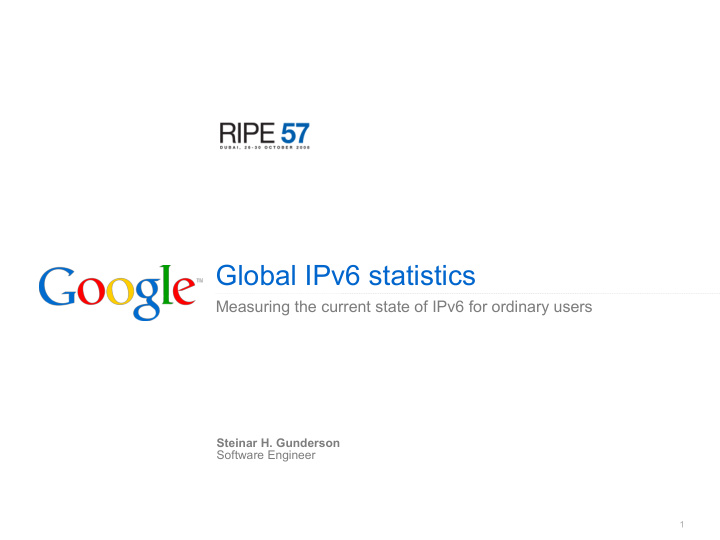



Global IPv6 statistics Measuring the current state of IPv6 for ordinary users Steinar H. Gunderson Software Engineer 1
Motivation • There is too little data about IPv6 among clients Existing measurements mostly on a small scale and/or only indirectly related to client IPv6 availability (e.g., IPv6 traffic percentage, IPv6-enabled ASNs) Best existing number is probably 0.086% (Kevin Day, March 2008) • General worry that turning on IPv6 can cause all sorts of brokenness Tunnels that someone forgot Suboptimal routing Home routers doing evil things to AAAA queries • We need to figure out how common IPv6 is among our users, how prevalent brokenness is, and how we can best serve our IPv6 users Our question: What is the impact of adding an AAAA record to a web site? 2
Methodology • Enroll a small fraction of ordinary Google users into an “IPv6 experiment”, where their browser is asked to perform a background request Involves users from all datacenters equally, but background request goes to one of two datacenters (one in the US, one in Europe) Cryptographically signed to avoid easy injection of false data 1. Search request www.google.* 2. Search results + background load ipv4.ipv6-exp.l.google.com 3. Background request or dualstack.ipv6-exp.l.google.com • Recorded information: IPv4 and IPv6 addresses, as applicable Image request latency Browser/OS details (User-Agent string) 3
Key figures Overview of connectivity and latency data 4
Connectivity • 0.238% of users have useful IPv6 connectivity (and prefer IPv6) • 0.09% of users have broken IPv6 connectivity That is, adding an AAAA record will make these users unable to view your site Due to statistical issues, this is a much less accurate figure (could easily be 0.06% or 0.12%), so take it with a grain of salt • Probably at least a million distinct IPv6 hosts out there Again, a number with statistical caveats 5
Connectivity development over time 0.26% 0.238% 0.237% 0.233% 0.230% 0.24% 0.220% 0.209% 0.207% 0.203% 0.22% 0.192% 0.192% 0.20% 0.18% 0.16% 0.14% 0.12% 0.10% 0.08% 0.06% 0.04% 0.02% -0.01% Aug 13 Aug 20 Aug 27 Sep 3 Sep 10 Sep 17 Sep 24 Oct 1 Oct 8 Oct 15 Week averages, 2008 6
Latency Latency distribution function, clients visiting ipv4.ipv6-exp.l.google.com Requests IPv4 host Time Note: This graph is not indicative of ordinary Google service latency Combined data, Aug–Oct 2008 7
Latency Requests IPv4 host IPv4 hit on dual-stacked host Time Combined data, Aug–Oct 2008 8
Latency, continued • We cannot directly graph IPv4 vs. IPv6 latency IPv6-enabled hosts are likely to have faster network connectivity overall (universities, power users, etc.) Need a way to remove inherent bias • Solution: Find pairs of hits from the same /24 IPv4 network, discard all other data Gives comparable (paired) data sets • This means we are measuring relative latency for a different set of users, but the data is still indicative of what you can expect today 9
Relative IPv4/IPv6 latency (paired data) Requests IPv4 150ms IPv6 Time Combined data, Aug–Oct 2008 10
Data breakdowns Drilling in to get a more detailed look 11
Connectivity by weekday (UTC) 0.28% 0.247% 0.26% 0.230% 0.24% 0.213% 0.213% 0.210% 0.210% 0.209% 0.22% 0.20% 0.18% 0.16% 0.14% 0.12% 0.10% 0.08% 0.06% 0.04% 0.02% -0.01% Mon Tue Wed Thu Fri Sat Sun Combined data, Aug–Oct 2008 12
Connectivity by country • Based on the IPv4 address, geolocate the user, then group by country Some countries with relatively little Internet traffic removed Country IPv6 penetration Russia 0.76% France 0.65% Ukraine 0.64% Norway 0.49% United States 0.45% … China 0.24% Japan 0.15% Combined data, Aug–Oct 2008 13
Connectivity by country 0.0% 0.7% Combined data, Aug–Oct 2008, lower bound of 68% confidence interval 14
Method of IPv6 connectivity • Based on the IPv6 address, we can infer how the user gets IPv6 access Unfortunately, no good way of distinguishing native from tunnels based on the address alone Vista with Teredo prefers IPv4 by default, so probably undercounted Method Global usage 6to4 67.9% Native/other 29.1% ISATAP 1.6% Teredo 1.4% • Some countries stand out United States, Canada: 95% 6to4 France: 95% native (almost all free.fr) China: 71% native, 25% ISATAP Combined data, Aug–Oct 2008 15
Breakdowns by OS IPv6 penetration and connectivity type by operating system Ranked by overall IPv6 penetration Native/other Teredo/ISATAP Operating system IPv6 penetration proportion 6to4 proportion proportion Mac OS 2.44% 9% 91% 0% Linux 0.93% 86% 13% 1% Windows Vista 0.32% 55% 43% 2% Windows 0.07% – – – Server 2003 Windows XP 0.03% 50% 30% 20% Windows 2000 <0.01% – – – 52% 97% of all IPv6 hits are from of all Teredo users are on Windows Macs with 6to4 (even undercounting Vista) Combined data, Aug–Oct 2008 16
Summary Brief analysis and conclusions 17
Overall trends • IPv6 prevalence is still low, but growing by the week Large (and sometimes surprising) variations among individual countries Still heavily influenced by single deployments (e.g., free.fr) • It's not that broken ~0.09% clients lost, ~150ms extra latency – don't believe the FUD • The default policy matters – a lot Vista: 10x IPv6 prevalence over XP (OS defaults to enabling IPv6) Mac OS: 8x IPv6 prevalence over Vista (Airport Extreme with 6to4 as default) • 6to4 is by far the most common transition mechanism (at least when you don't count Vista's not-preferred-by-default Teredo) Probably in part due to the AirPort Extreme Consider running your own 6to4 relay for return packets 18
Future work • Keep it running Gather more data as time goes by • Figure out why we lose users on the way So we can fix it • Run different experiments to get more accurate loss numbers Paired data (i.e., two separate background requests) has been done before and is a possibility, but does not solve all problems More client-side logic would help 19
Questions? 20
Recommend
More recommend